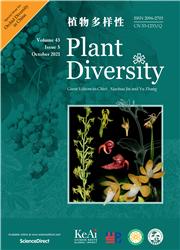横断山地区二花荞麦和同花荞麦授粉成功的海拔和时间格局
IF 6.3
1区 生物学
Q1 PLANT SCIENCES
引用次数: 0
摘要
两性二形植物的生殖策略随环境的变化而变化。在这里,我们询问荞麦种的性系统(即自交同花柱和异交二花柱)是否代表了不同的适应策略,以提高在变化的高山环境中的繁殖成功率。为了回答这个问题,我们在中国西南横断山区海拔1299 ~ 3315m的海拔梯度上,测定了空间和时间因素(如海拔和花期高峰)对9个野生Fagopyrum物种(7个双花柱和2个同花柱)28个种群的繁殖成功率(即柱头花粉负荷)的影响。我们还观察了传粉媒介,并进行了数百次手传粉,以研究4种荞麦(2种二花束和2种同花束)的形态间/形态内相容性、自相容性和花粉限制。研究发现,海拔较高的荞麦种通常花较大,柱头花粉含量较高;晚花期个体花较小,花粉沉积较少。柱头花粉沉积在二花种中比在同花种中变化更大。尽管并非所有物种的结实率都受花粉限制,但我们发现,依赖于频繁传粉者的二花种的结实率远低于能够自主自花授粉的同花种。我们的研究结果表明,在高海拔地区,传粉成功率增加,而在开花季节,传粉成功率降低,这表明二花和同花物种在空间和时间上具有不同的生殖策略,这与环境依赖的传粉者活动有关。本文章由计算机程序翻译,如有差异,请以英文原文为准。
Elevational and temporal patterns of pollination success in distylous and homostylous buckwheats (Fagopyrum) in the Hengduan Mountains
Reproductive strategies of sexually dimorphic plants vary in response to the environment. Here, we ask whether the sexual systems of Fagopyrum species (i.e., selfing homostylous and out-crossing distylous) represent distinct adaptive strategies to increase reproductive success in changing alpine environments. To answer this question, we determined how spatial and temporal factors (e.g., elevation and peak flowering time) affect reproductive success (i.e., stigmatic pollen load) in nine wild Fagopyrum species (seven distylous and two homostylous) among 28 populations along an elevation gradient of 1299–3315m in the Hengduan Mountains, southwestern China. We also observed pollinators and conducted hundreds of hand pollinations to investigate inter/intra- morph compatibility, self-compatibility and pollen limitation in four Fagopyrum species (two distylous and two homostylous). We found that Fagopyrum species at higher elevation generally had bigger flowers and more stigmatic pollen loads; late-flowering individuals had smaller flowers and lower pollen deposition. Stigmatic pollen deposition was more variable in distylous species than in homostylous species. Although seed set was not pollen-limited in all species, we found that fruit set was much lower in distylous species, which rely on frequent pollinator visits, than in homostylous species capable of autonomous self-pollination. Our findings that pollination success increases at high elevations and decreases during the flowering season suggest that distylous and homostylous species have spatially and temporally distinct reproductive strategies related to environment-dependent pollinator activity.
求助全文
通过发布文献求助,成功后即可免费获取论文全文。
去求助
来源期刊

Plant Diversity
Agricultural and Biological Sciences-Ecology, Evolution, Behavior and Systematics
CiteScore
8.30
自引率
6.20%
发文量
1863
审稿时长
35 days
期刊介绍:
Plant Diversity (formerly Plant Diversity and Resources) is an international plant science journal that publishes substantial original research and review papers that
advance our understanding of the past and current distribution of plants,
contribute to the development of more phylogenetically accurate taxonomic classifications,
present new findings on or insights into evolutionary processes and mechanisms that are of interest to the community of plant systematic and evolutionary biologists.
While the focus of the journal is on biodiversity, ecology and evolution of East Asian flora, it is not limited to these topics. Applied evolutionary issues, such as climate change and conservation biology, are welcome, especially if they address conceptual problems. Theoretical papers are equally welcome. Preference is given to concise, clearly written papers focusing on precisely framed questions or hypotheses. Papers that are purely descriptive have a low chance of acceptance.
Fields covered by the journal include:
plant systematics and taxonomy-
evolutionary developmental biology-
reproductive biology-
phylo- and biogeography-
evolutionary ecology-
population biology-
conservation biology-
palaeobotany-
molecular evolution-
comparative and evolutionary genomics-
physiology-
biochemistry
 求助内容:
求助内容: 应助结果提醒方式:
应助结果提醒方式:


